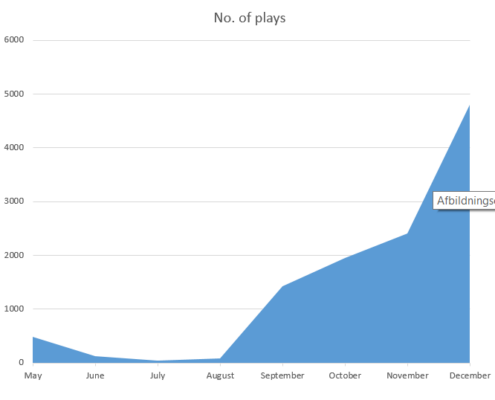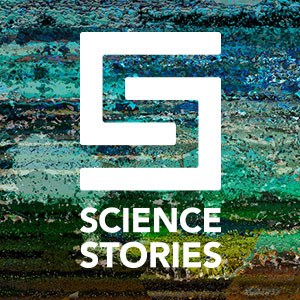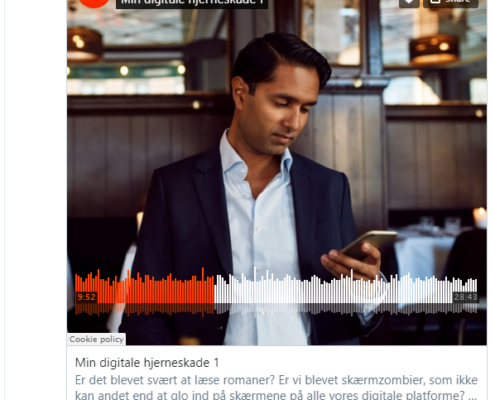The Science Stories podcast – getting people to listen
It is easy to get people to click once. More difficult to get people to listen. And even harder to get people to click on that follow/subscribe button.
I am helping out with a project called Science Stories, a Danish-language podcast series that also airs on local radio. Each episode consists of an interview or talk by a scientist, and covers everything from surviving in outer space, to the cardiac capacities of horses. It is fascinating, informative, well-produced by accomplished Danish journalists, and now has more than 50 episodes that you can scroll through and see here.

Artist’s impression from the video ‘Hera: ESA’s Planetary Defence Mission’ (credit; ESA) and illustration to the podcast episode on Space Safety called ‘It’s only a question of time before the Earth is hit’.
It started up in May last year, and my job is to get the Science Stories podcasts in front of a bigger audience. So far, this has been by working out a social media and distribution strategy, doing a social media workshop for the science journalists, and by organising the different Science Stories’ social media streams, primarily Facebook and Twitter. I have had a small budget for social media advertising.
As a journalist and editor, I know a lot about getting people to click and read. What I did not know much about before I started working on this project was how to get people to click and listen. How do you get other people to click and play or, even better, to click and subscribe to your shows and playlists?
The strategy
At Science Stories, we hope to gain a large and loyal group of listeners. The point of our social media activity is not to lure people into clicking onto a webpage; it is to get curious listeners to voluntarily opt into subscribing and following our podcasts so that they listen to us again, and again. This can be a challenge when most people understandably prefer to avoid clicking on anything – or if they do click, to click in and bounce out, never to come back again.
This has implications for what we post. Given that this is our long-term goal, social media posts always have the purpose of getting followers and subscribers on the podcast platforms where Sound Stories is hosted and played, rather than, say, one-off traffic to our website ScienceStories.dk. When a listener ‘follows’ or ‘subscribes’ to us on a hosted podcast provider like Apple Podcasts (for iPhones), Spotify, or SoundCloud, we are on their phones, available, when they open their podcasts on their daily commute. Listeners can also see new podcasts when they are released, and will often shop around in our backlog of podcasts, depending on the listeners’ interests. This traffic to our older backlog, and returning traffic from our followers, will, we hope, make up a larger and larger portion of our play statistics in the longer term.
How has it gone so far?
Below is a graph showing the development in traffic measured in ‘plays’ of Science Stories’ podcasts in 2019. The traffic is only podcast traffic and does not include listening numbers via our local radio partner. A total of 49 programmes were released between the launch in April 2019 and the end of the year. Science Stories achieved 11,321 plays.

Plays of Science Stories’ podcasts in the period April to December 2019. The graph is based on numbers from the statistics shown on our podcast-host SoundCloud.
The graph looks exponential. And traffic has continued this growth path, through year-end, to the time of writing (January 2020). At some point the graph will drop off and become linear, I expect, as new subscribers cannot be expected to listen to all new programmes, and there is a limit to the number of interested people who can listen.
Here below is one of Science Stories’ podcasts, an English-language interview with Nobel Prize winner Michael Rosbash. You can click and listen:
Our social media posts have mostly been intended to make our followers/subscribers aware of new podcast releases (49 of them in 2019), and to achieve the (difficult) recruitment of new followers and subscribers, preferably directly on their podcast players like Spotify and Apple Podcasts.
After an initial slow pick-up of subscribers and followers, these numbers are now going up, and Science Stories is now gaining a good proportion of its total play traffic from listeners who have chosen to follow/subscribe to us on the main podcast players.
It looks good, but the exponential increase in the number of plays is actually no big surprise to me. Especially for a podcast that’s uploading good, new content at a constant rate, and where older episodes are also gaining new traffic with every new subscriber and follower. Remember, each time a new visitor arrives on the site, or subscribes to a feed, they now have a whole backlog of podcasts that they can listen to. This means that later subscribers, and later website visitors have a higher incentive to listen to a lot of podcast episodes.
I hope we can keep it up!
What we do on each platform
One of the fortunate side effects of our social media activity has been increasing follower numbers on Facebook and Twitter. Our numbers here have been growing, no big revelations here, with 671 following us on Facebook and 531 following us on Twitter at the time of writing.
Our Twitter and Facebook tactics are different, but they both play into the overall strategy of aiming for returning listeners rather than one-off clicks.

If you see this logo, please follow!
We post on both platforms in Danish to a Danish-speaking audience.
In Denmark, Twitter is the preferred platform for scientists, professionals, policymakers, and interest groups. As a platform, it is ideal for making scientists who work in the same field as a specific podcast episode aware of it. For promoted (paid) posts, its algorithms also allow us to target audiences with specific interests like, say, astronomy for podcasts on space. We tag the scientists in our posts to make them aware of programmes that touch on their specific expertise, allowing them to retweet to their followers, who, of course, are already interested in their field.
On Twitter posts (tweets), our programmes can actually be directly embedded. Listeners can start a programme with one click (see image below). This, in effect, turns Twitter into a hosting platform in and of itself, so that our Twitter followers are, for all intents and purposes, a ‘subscriber’ to our feed. Scrolling down our Twitter profile is an easy way for potential listeners to get an overview of what programmes we have to offer.

When podcasts can be embedded directly on a platform, the platform becomes the host. Scrolling down can be the best way to see the offering of episodes.
Facebook is shunned by the elites, and by the young. But it is still the most popular social media platform in Denmark. And it still gets science-interested people to click on the headline, go to the page on a website … and listen. Without regular boosts (advertising of specific posts), the circle of followers on Facebook remains relatively static and localized. For this reason, we have made targeted boosts of the posts that have already proven to perform well organically.
We are also present on LinkedIn, so far without spending a lot of time and energy there, but you are welcome to follow us if you want!
We plan to have a larger presence on YouTube in 2020. Right now, there is a nice set of shorter videos with kitchen science.
More than 70 per cent of traffic to the ScienceStories.dk website comes directly from social media (people clicking on a link that is posted on Facebook or Twitter).
Science Stories organizes a series of small-scale public events called ‘Videnskabssaloner’ or science salons, which are wonderful ways to get out and meet sciencey people if you are in the Copenhagen area. Some of these events can also be seen on our YouTube channel.
Is it working?
I think so.
The idea is to support the growth in the number of plays by convincing listeners to subscribe and follow us on podcast players, rather than to get visits to our own website. The strategy is starting to pay off: A large proportion of our traffic to new programmes now already comes from returning listeners.
So things are going well.
During the course of the Science Stories project, I got valuable advice from marketers like ‘Maggie’ Jane Magaard, and podcasters like Camilla Lærke Lærkesen and Mark Khurana. Thanks guys!
If you understand Danish I recommend you try out one of the podcasts on our list here. Follow us on:
☞ Facebook
☞ Twitter
☞ Apple/iTunes
☞ Spotify
☞ RSS
If you are interested in any of my communication services, you can get an overview here.

 Credit: ESA – Science Office
Credit: ESA – Science Office

Skriv en kommentar
Want to join the discussion?Feel free to contribute!